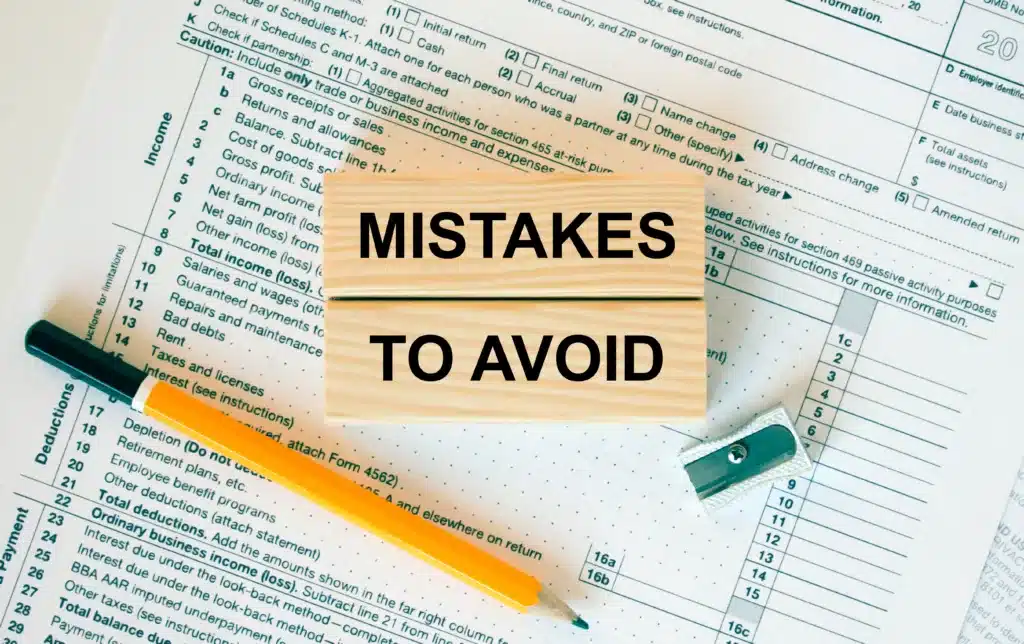How To Correct Errors on Your Tax Return

Preparing and understanding tax returns can be a complicated and challenging process. Even tax professionals sometimes face difficulties to ensure every number and detail is accurate. Often, errors on tax returns are only discovered after filing electronically or sending it via mail, or in more unfortunate cases, when the IRS notifies you of discrepancies. If you find yourself in this situation, it’s important to know what to do next.
The good news is that there are steps you can take to fix the errors. If you’re not sure where to start, it’s a good idea to get help from a tax expert. Our team of experts specializes in navigating the intricacies of the IRS and can provide you with peace of mind.
Three Common Tax Return Errors
The IRS looks at each tax return closely to see if there are any red flags. Here are three errors that taxpayers frequently make- and what you can do to avoid them.
- Not disclosing all income. No matter how much you generated, it’s crucial to accurately declare all your income. Note that duplicate copies of your W-2, 1099, and other income forms are sent to the IRS unless you operate a cash-only business (which can be suspicious). Disparities between reported and actual income can raise red flags with the IRS.
- Inflating business expenses. Depending on your profession, there might be valid expenses. If you’re a business owner, there may be a temptation to overstate deductions. While certain deductions can be legitimate, it’s vital to stick to the accepted list and avoid claiming excessive deductions. To ensure compliance with tax laws and prevent incorrect deductions on your tax return, it’s advisable to seek guidance from a tax professional.
- Computation errors. Whether you file electronically or on paper, your information is input into a computer system. Computers are highly proficient at performing mathematical calculations, which means any mistakes or inconsistencies are easily noticeable. While a math error might not directly result in an audit, it can draw unwelcome scrutiny. To avoid such issues, it is advisable to thoroughly review your tax returns and seek assistance from a qualified tax professional.
Amending Your Tax Return – Form 1040X
Individual income tax returns may be amended by submitting Form 1040X within three years of the original due date.
This form enables you to update the IRS with the information initially filed, the corrected details, and the explanation for the modifications. Furthermore, it allows for adjustments to personal exemptions, such as the correction of errors concerning dependents.
Five Tips for Filing the 1040X Form
- Use a separate 1040X form and envelope for each year you need to amend, and send each one in its own envelope
- Make sure to clearly write the tax year at the top of each form.
- Explain the modifications you’re making and the reason on the back of the form. Include any schedules, forms, or supporting documents that will be affected by the changes.
- If your modifications to the federal taxes affect your state taxes, you must also file a revised state tax return.
- When filing your amended return, consider enlisting the assistance of a tax resolution professional. They can help you file multiple years of unfiled tax returns, negotiate a lower settlement amount, and provide useful tax related advice.
You Have Three Years to Correct Errors
Often, taxpayers only realize mistakes in their tax returns when they’re preparing returns for subsequent years. You may discover these errors while you’re discussing with tax preparers or doing a personal review. The good news is that there is no specific deadline for amending a tax return. You can make corrections whenever you found an error. It is crucial to note, however, that the IRS usually accepts corrections within three years of the original filing date.
Filing Form 1040X
Regardless of whether or not you usually e-file your tax returns, it’s important to know that you can only paper file the 1040X form.
At present, the IRS does not accept electronic filing of the 1040X form. Make sure to use the correct mailing address for the form, as it differs from the address for regular returns.
If Correcting Errors Leads to Additional Taxes Due
If you happen to identify an error on your tax return that leads to an underreporting of your tax liability, it is critical to amend your return as soon as possible. Failing to do so may result in the IRS discovering significant discrepancies, such as unreported income from freelancing or self-employment. This could lead to extra charges like interest and penalties on top of the taxes you owe. Proactively dealing with the error can help minimize the impact of interest charges.
If you expect to owe a substantial amount in taxes, exceeding $10,000 to the IRS or state and are unable to afford full payment in a lump sum, we recommend reaching out to our firm for assistance. We specialize in providing support to individuals seeking tax relief and, in certain cases, helping them settle their tax debt for a fraction of the total owed if they qualify. Feel free to reach out to us for a resolution.
Correcting mistakes on your tax return is important for maintaining compliance with IRS regulations and reducing potential penalties. By taking the necessary steps to amend your return with the guidance of a tax resolution professional, you can ensure accuracy and alleviate any worries about your tax situation.
